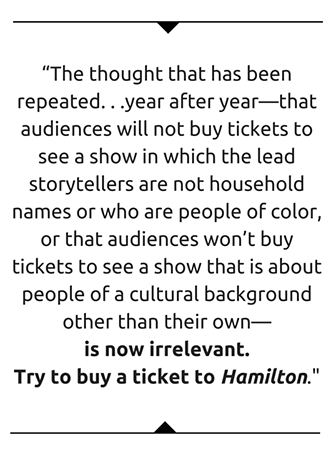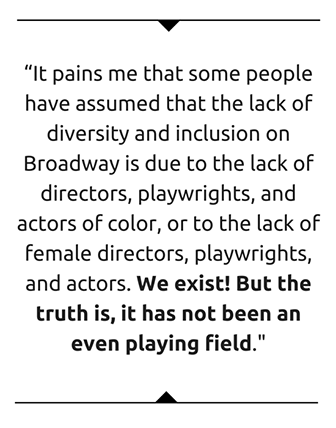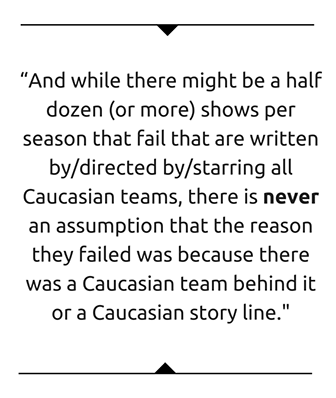![]() This year’s Tony Awards will be broadcast on Sunday, June 12, 2016. We posted our first infographic and study on the Diversity Gap in the Tony Awards in 2013. In 2014, we did a brief follow-up post. In 2015-2016, there was such a pronounced uptick of diverse productions on Broadway that we felt it was worth updating our infographic and taking another look at diversity in the theater industry.
This year’s Tony Awards will be broadcast on Sunday, June 12, 2016. We posted our first infographic and study on the Diversity Gap in the Tony Awards in 2013. In 2014, we did a brief follow-up post. In 2015-2016, there was such a pronounced uptick of diverse productions on Broadway that we felt it was worth updating our infographic and taking another look at diversity in the theater industry.
This year, Broadway megahit Hamilton—which almost exclusively stars actors of color—broke Tony records with a whopping 16 nominations. Add to that nominations for The Color Purple, Eclipsed, and Shuffle Along, and we’re in a year where conceivably all the main acting Tonys could go to people of color. But is this year’s diversity a sign of lasting change, or an anomaly? To find out, we touched base again with award-winning writer, actor, and director Christine Toy Johnson to get her take on the current state of diversity in theater. Welcome, Christine!
- With the critical and commercial success of Hamilton, do you feel that this play will have a “rising tide lifts all boats” effect on theater and will result in more opportunities for diverse actors and actresses?
Of course that’s the great hope. The thought that has been repeated and repeated year after year—that audiences will not buy tickets to see a show in which the lead storytellers are not household names or who are people of color, or that audiences won’t buy tickets to see a show that is about people of a cultural background other than their own—is now irrelevant. Try to buy a ticket to Hamilton.
Still, I don’t think we’ve seen the end of our challenges, by a long  shot. I think that we, as a nation, are at this profound crossroads of sorts. On one hand our society has become more inclusive than ever in our laws and policies. On the other hand, it has become more divisive than ever with fear based hate rhetoric making it clear that many view inclusion as a threat to the status quo, instead of an opportunity to expand and enrich the status quo. Even in the most subtle and subconscious ways, I think that this trickles down into every corner of our lives, including how we make art, how it’s perceived, and how it’s produced. I think we should celebrate this season with a cautious optimism, and use it as inspiration to keep working toward raising that tide and lifting those boats!
shot. I think that we, as a nation, are at this profound crossroads of sorts. On one hand our society has become more inclusive than ever in our laws and policies. On the other hand, it has become more divisive than ever with fear based hate rhetoric making it clear that many view inclusion as a threat to the status quo, instead of an opportunity to expand and enrich the status quo. Even in the most subtle and subconscious ways, I think that this trickles down into every corner of our lives, including how we make art, how it’s perceived, and how it’s produced. I think we should celebrate this season with a cautious optimism, and use it as inspiration to keep working toward raising that tide and lifting those boats!
Here’s a link to a piece I wrote about Hamilton that expands on some of my thoughts on the show’s impact.
- While years of vigilance and activism has been a contributing factor in more diverse casting, what has been your take on why so many productions in 2016 were diverse?
I think it’s been the perfect storm of programming and casting that happened to converge this season. From most reports, next season does not look nearly as diverse. So though I’d love to think this season is so diverse because the tide has changed for good, I think it’s diverse because the tide has turned for some creative teams and/or this is the year they’re getting their shot and we’re lucky enough to see the fruits of their labor right now.
- Obviously, diverse decision makers are key to hiring and casting more diverse casts. Has there been an increase in diversity among directors, playwrights, and producers in theater? Are there new creators breaking into Broadway who we should be aware of?
 It pains me that some people have assumed that the lack of diversity and inclusion on Broadway is due to the lack of directors, playwrights, and actors of color, or to the lack of female directors, playwrights, and actors. We exist! But the truth is, it has not been an even playing field. Of course this is multi-layered, as is every other issue we’re discussing here. Taking a chance on someone who hasn’t had an opportunity to have a big commercial success yet is of course full of great financial risk. But I think this becomes a vicious circle. How do you get the opportunity to have a commercial success if you aren’t allowed the opportunity in the first place?
It pains me that some people have assumed that the lack of diversity and inclusion on Broadway is due to the lack of directors, playwrights, and actors of color, or to the lack of female directors, playwrights, and actors. We exist! But the truth is, it has not been an even playing field. Of course this is multi-layered, as is every other issue we’re discussing here. Taking a chance on someone who hasn’t had an opportunity to have a big commercial success yet is of course full of great financial risk. But I think this becomes a vicious circle. How do you get the opportunity to have a commercial success if you aren’t allowed the opportunity in the first place?
I also think that on a deeper level we are running up against a problem of narrowed perceptions, which lead to what certain producers expect writers of color to be writing about. And if we don’t fit their expectation or profile for us then we’re just not part of their equation. And while there might be a half dozen (or more) shows per season that fail that are written by/directed by/starring all Caucasian teams, there is never an assumption that the reason they failed was because there was a Caucasian team behind it or a Caucasian story line. But if the numbers are poor for a show featuring a non-Caucasian cast/writer/director, many will be quick to make an assumption that these kinds of stories/writers/directors/actors just don’t sell tickets and aren’t worth the risk.
There are so many writers of color who deserve to break through in a bigger way than they already have: Timothy Huang, Adam Gwon, Nikkole Salter, Leah Nanako Winkler, Jason Ma, Lloyd Suh, to name just a few. As for Asian American producers, I know there are several who are doing great stuff on Broadway, especially Lily Fan and Jhett Tolentino.
- Following Hollywood’s #Oscarssowhite controversy, do you know if there are any efforts underway to recruit more people of color to join the various organizations that are eligible to vote on Tony Award nominees? (Note: this year, according to our research, the Tony Awards Nominating Committee was 86% white and 70% male).
Tony voters are largely made up of the elected leaderships of various  arms of the industry (i.e. Dramatist Guild, Actors’ Equity Association, SDC, etc., as well as many producers and presenters) and I do believe that there is an ongoing effort to diversify those memberships. But it goes beyond that, since we are talking about the Tony nominators and voters coming from within those ranks. In other words, yes, it’s great to increase the diversity of these memberships, but it’s not a simple solution to increasing the make up of Tony voters or Tony nominators.
arms of the industry (i.e. Dramatist Guild, Actors’ Equity Association, SDC, etc., as well as many producers and presenters) and I do believe that there is an ongoing effort to diversify those memberships. But it goes beyond that, since we are talking about the Tony nominators and voters coming from within those ranks. In other words, yes, it’s great to increase the diversity of these memberships, but it’s not a simple solution to increasing the make up of Tony voters or Tony nominators.
- More diverse casting and storylines will result in more diverse theater audiences. Seems to us this is an opportunity for the theater industry to grow. Do the powers that be really get it or is 2016 an anomaly when it comes to the spike in diverse productions?
We have been having this same discussion for more than a decade, citing the same philosophies and reasoning. I can only hope that the numbers this year help to reinforce the idea. Time will tell.
 CHRISTINE TOY JOHNSON is an award-winning writer, actor, director, and advocate for inclusion. Member: Dramatists Guild Council, Actors’ Equity Association Council (and national chair of the union’s EEOC), Asian American Composers and Lyricists Project (founder), Executive Board of Alliance for Inclusion in the Arts, founding steering committee member of AAPAC. She is also an alumna of the BMI Workshop and a member of ASCAP, AEA, and SAG-AFTRA.
CHRISTINE TOY JOHNSON is an award-winning writer, actor, director, and advocate for inclusion. Member: Dramatists Guild Council, Actors’ Equity Association Council (and national chair of the union’s EEOC), Asian American Composers and Lyricists Project (founder), Executive Board of Alliance for Inclusion in the Arts, founding steering committee member of AAPAC. She is also an alumna of the BMI Workshop and a member of ASCAP, AEA, and SAG-AFTRA.









